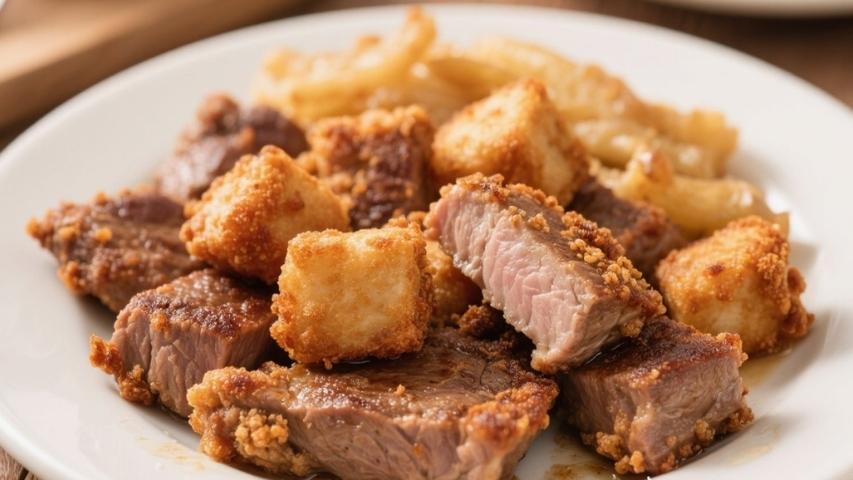You might have noticed meat tenderizer powder in the spice aisle and wondered if it really works. We tried it out on a tough, $1 eye round steak to find out if this pantry staple can make a cheap cut tender and tasty.
We love finding ways to make affordable meat taste great. After trying many methods, pineapple has become our favorite for tenderizing. It works because of an enzyme called bromelain, which breaks down tough meat fibers. (Bromelain Kinetics and Mechanism on Myofibril from Golden Pomfret (Trachinotus blochii), 2018, pp. 629-636) Interestingly, many meat tenderizer powders also use bromelain. (Seasoned Meat Tenderizer, n.d.)
So, the big question is: can this powder compete with the natural power of pineapple? We set up an experiment to compare the tenderizer, fresh pineapple, and a control steak to determine the outcome.
Our Experiment: Tenderizer vs. Pineapple

We needed a tough cut to really test these methods. Eye of round steak is perfect—it’s cheap, flavorful, and very chewy. (Eye of Round Steak – Traeger Grills, n.d.) If we can make this tender, the method works.
We prepared three steaks for our test:
- The Pineapple Steak: Marinated in fresh pineapple for one hour.
- The Tenderizer Steak (As Directed): Moistened with water, sprinkled with tenderizer, and pierced with a fork at half-inch intervals, as per the product instructions.
- The Tenderizer Steak (No Piercing): Prepared with the tenderizer but without piercing, to see if the powder could work its magic on its own.
We let the pineapple and tenderizer steaks rest in the fridge for an hour. Since the tenderizer instructions said to cook right away, we also made a fourth steak, following the directions exactly, to see if resting made a difference.
After an hour, we checked the steaks. The pineapple-marinated one was much softer, almost falling apart. The pierced steak was tender, but the un-pierced steak was still pretty firm, almost like it was raw. This made us think that using a fork to pierce the meat might be the main reason for the tenderness.
Cooking the Steaks
We seasoned all the steaks with black pepper and garlic powder. The tenderizer instructions said not to use salt, so we left it out for all but the pineapple steak. We cooked each steak in a hot pan with butter until they reached 135°F for medium-rare.
The Side Dish: Family-Style Loaded Potatoes
While the steaks marinated, we made a favorite side dish: loaded potatoes. They’re easy to make and go perfectly with steak.
How to Make Loaded Potatoes
- Prep the Potatoes: Start with small potatoes, toss them in olive oil, and season generously with salt and pepper.
- Bake: Bake at 350°F for one hour, or until the skins are crispy and the insides are tender.
- Cook the Bacon: While the potatoes bake, cook the bacon until it’s crispy. Be sure to save the bacon fat; it’s great for other recipes.
- Make the Garlic Butter: Melt the butter in a pan and add a small amount of garlic paste. Let it meld together for a minute.
- Assemble and Bake Again: Cut the baked potatoes into one-inch cubes. In a baking dish, layer the potatoes, sour cream, bacon, garlic butter, and shredded provolone cheese. Keep layering until you use everything. Bake at 350°F until the cheese is melted and bubbling.
- Garnish and Serve: Top with fresh green onions and serve hot. This dish is rich, savory, and the perfect complement to our steak experiment.
The Results Are In
Once the steaks were cooked and rested, we tasted each one to see which tenderizing method worked best.
Control Steak (No Tenderizer): This steak tasted fine, like eye round usually does, but it was very tough to chew, just as you’d expect from a $1 cut.
Pineapple-Marinated Steak: The steak had an incredibly soft texture. The pineapple did its job so well that the meat was almost falling apart. However, the pineapple flavor was very noticeable, and it created a wet crust that prevented a good sear.
Tenderizer Steak (No Piercing): This one didn’t work well. It had a strange, dusty taste and wasn’t much more tender than the control steak. It also really needed salt.
Tenderizer Steak (As Directed, with Piercing): This steak was definitely softer. Piercing the meat clearly helped. It was more tender, but still had a strange aftertaste and really needed salt.
Tenderizer Steak (Cooked Immediately, As Directed): Following the instructions exactly made a difference. The steak was pretty tender, and the off-flavor was less noticeable. Still, the lack of salt was a big drawback. Adding salt after cooking helped, but it still wasn’t as good as the best method.
Our Final Verdict
So, is meat tenderizer powder worth it?
If you follow the directIf you follow the directions exactly, by piercing the meat and cooking it right away, the tenderizer does make a tough steak more tender. However, it adds a flavor that not everyone will like, and leaving out salt makes the steak taste bland. Pineapple is still the winner. It delivers superior tenderness, and while the flavor is strong, it’s a natural and enjoyable taste.
Meat tenderizer powder might work better in dishes like stir-fries, where the meat is cut small and covered in a flavorful sauce that hides the aftertaste. For a simple, tasty steak, we suggest using natural methods or choosing a better cut of meat.


